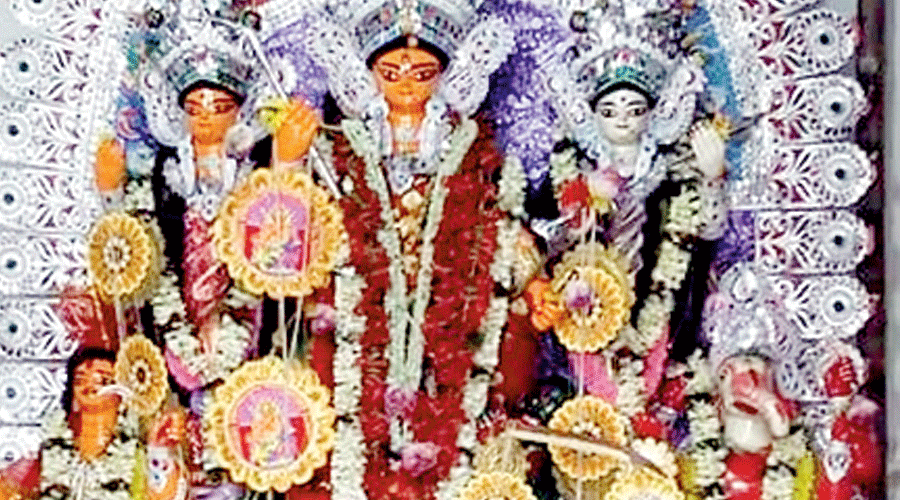The descendants of a landowning Chatterjee family in Patuli village of Hooghly’s Balagarh perform Durga Puja rites according to Buddhist norms, highlighting a unique aspect of the festival’s multicultural nature.
The members of the Chatterjee family perform Durga Puja rituals going by the Buddhist Mahayana tradition.
This year, three generations of the family arrived at their ancestral home in Balagarh to celebrate the event that is over 450 years old.
The main feature of this traditional family event is the Yogini Puja that includes “human sacrifice” performed in a symbolic way. Goddess Durga, installed in the math, is known as “Mather Maa” (mother of the monastery) and is offered the “sacrifice”.
A human figurine made of rice flakes is sacrificed late on Saptami night. The “meat” of the sacrificed figurine is offered to the deity as bhog.
Here, Goddess Durga is not offered 108 lotus flowers as is seen elsewhere across the state.
In a gesture of respect to the mother goddess, the deity of the Chatterjee family is immersed first over all other community pujas at the Balagarh ghat of the Hooghly river on Dashami.
According to family sources, the ancestors of the Chatterjees, who were followers of the “Mahayana” way of Buddhism and residents of Patliputra, had migrated to Balagarh in Hooghly over five centuries ago.
In Balagarh, the ancestors set up their “zamindari”. A large number of downtrodden people from tribal communities lived in the area during the time and eventually accepted Mahayana Buddhism. The Chatterjees began Durga puja at the math to woo the local residents who were their subjects.
Historian and researcher Partha Chattopadhyaya, a professor of Jirat College, shed light on this aspect of the Puja in Balagarh.
“Contemporary Buddhist scripts indicate that in the course of time, the zamindar family and their subjects converted to Hinduism but they continued to practice Mahayana ways in certain religious rituals. It appears that the descendants of the zamindar family have been following the same Mahayana ways till now even though they are no longer practising Buddhists.”
Chattopadhyay added that he recently located 52 Buddhist scripts from a house in Tentulia village of Balagarh, which are some 500 years old.
“Most of these Buddhist scripts contain the procedures to perform Durga Puja. These scripts vividly described the ways of Yoginia Puja as a part of Durga Puja, which has quite a resemblance to the Yogini worship of Buddhism. The traditional Durga Puja of the Chatterjee family is a living example of the way the scripts describe this form of worship.”
Speaking to The Telegraph, the present head of the zamindari descendants, Tapas Chatterjee, said: “We have no clear record of when our ancestors turned Hindu and began the Durga puja in the Buddhist way. But I have been observing this is the way we worship the Mother Goddess since my childhood. It is different from the Durga Puja that we usually see across Bengal. We have specific scripted methods of worship and generations of a family from Haripal in Hooghly has been performing the puja for over centuries.”
“The scripted method was damaged a few years ago and we have got it rewritten from Benaras,” Chatterjee added.
“The venue where Goddess Durga is installed now and the puja is organised actually used to be a Buddhist monastery. The architectural lines of the math do not match with the look of a monastery since it has transformed over the years. But a Buddhist link can be ascertained from the existence of a bust of Gautama Buddha inside the math, which is few centuries old and has never been removed,” added Chatterjee.











